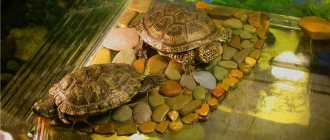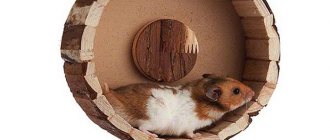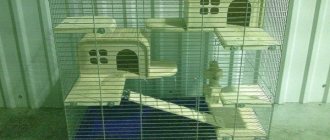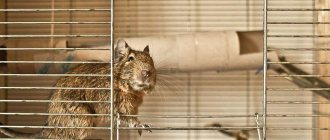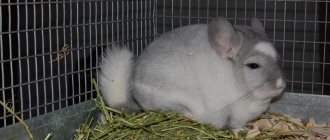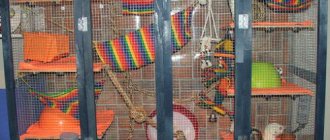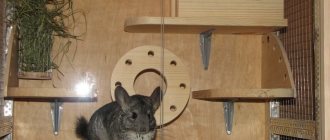- home
- Housing
13.04.2018
Hamsters are nimble animals that need a house that meets all their requirements. The necessary paraphernalia is quite expensive. Therefore, rodent owners often think about building their own housing for their pet. It is rarely possible to make a hamster cage with your own hands from available materials. But with some effort and purchasing the necessary materials, you can build a real palace. The cost of a homemade cage will be lower than a ready-made cage purchased in a store.
Requirements for cages for keeping rodents
Housing for comfortable living of hamsters has its own characteristics.
Size and shape
The main requirements for an animal's cage relate to its size. According to experts from different countries, keeping a hamster requires organizing a large space. At the same time, different zoologists call different numbers. But most researchers agree that a pet's cage should be at least 2900-6000 cm², and its height should be 30 cm or more.
Pet stores sell small housing for hamsters, but for a comfortable life for a rodent, it is better that the enclosure is approximately 70x80 cm or slightly smaller.
The most convenient cells are square and rectangular. A spherical-shaped home is more difficult to clean.
Distance between rods
If the hamster's place of residence consists of separate rods, the distance between them should be small. It depends on the size of the pet. The main task is to prevent the animal from getting out.
The distance between the rods should be small.
The smallest, dwarf breeds or cubs should live in housing with a size between the bars of no more than 5-6 mm.
For Syrian hamsters or larger individuals, the rods should be spaced no more than 10-12 mm apart.
Design features
A house for a rodent can be solid - made of wood, glass or plastic - or made of rods, gratings, nets.
Advantages of continuous housing:
- the animal is reliably protected from other pets living in the house - for example, cats;
- the hamster will not fall while climbing walls.
However, there are some disadvantages:
- odors accumulate faster;
- housing will have to be cleaned more often;
- a solid structure is less ventilated.
Advantages of a house made of twigs:
- the cage is well ventilated;
- The hamster’s housing is easy to clean;
- you can observe the actions of the animal.
The hamster's housing is convenient to clean, the cage is ventilated.
It is better when the bars are located horizontally so that the pet can climb them like a ladder. But it is desirable that the cage is not high, because... the animal may fall.
But you need to take into account that a hamster can chew through soft metal or swallow paint. It is better to buy an enclosure made of durable rods coated with a stainless steel compound. In addition, in this case, hamsters can climb walls that consist of horizontal rods and fall from a height. This may cause injury.
In addition to simple enclosures, they can be multi-story, modular, with shelves for climbing, etc.
In multi-storey cages, the area of each level must be no less than the previously specified dimensions. It is better to choose solid ceilings so that the animal cannot get injured. Each level is connected to the other using stairs or wide tunnels.
Material of manufacture
Solid structures are most often made of durable plastic. It must be non-toxic, because... the hamster may chew on protruding parts. Most often, housing for pets is made of acrylic, because... Thanks to its finely porous structure, it is easy to clean.
The main disadvantage of this material is the absorption of odors. It is difficult to eliminate this unpleasant phenomenon even with the help of modern means.
Some animal owners prefer to keep hamsters in a glass aquarium. This is a bad option because... such a place to keep an animal is poorly ventilated. To improve ventilation and prevent fogging of the walls, the width of the aquarium should be greater than the height.
A glass aquarium is poorly ventilated.
Some dwellings are made of wood. It should be remembered that a hamster can chew through its house. Its walls should be thick, made of hard rock.
There are combined products that are made from different types of materials.
The best material is considered to be nickel-plated metal, from which rods for homes are made. It is easy to wash and does not absorb odors. This habitat is well ventilated.
The tray is hygienic, even if it is made of plastic, since it is covered with a layer of filler of at least 5 cm.
However, cages with metal bars have a drawback: a lot of noise from the hamster's movements.
How many hamsters can live in one cage?
Small breeds of hamsters (except Djungarian) can be placed in one cage. Bergman's hamsters are considered the most social. But keeping several animals together will require more space than keeping one.
Vintage basket
Here we are dealing with a representative design in the style of modern rural fashion. Best suited for lovers of cycling or short distance travel on scooters. The basket itself is woven from flexible willow and equipped with an openwork wire lid, which prevents the cat from wanting to get out while moving. At the first glance at such a carrier, one is reminded of idyllic pictures from centuries ago, when food from the market was transported in a similar way on bicycles. The entire structure is conveniently attached to the steering wheel using leather straps and does not require much time for preparation.
The advantage of the option under consideration is, of course, its original design and originality. The downside is limited functionality. Although, if desired, the basket can be used for its intended purpose.
Price – 1,128 – 1,708 rubles.
How to choose a cage for a hamster
To choose a suitable cage for a pet, you need to focus on the general requirements for the animal’s home and its breed. Small decorative hamsters can live in a small cage, but large individuals will need a more spacious home.
To prevent your hamster from becoming obese, you need to equip its habitat with accessories that allow it to actively move: a running wheel, stairs, tunnels.
For rest and sleep, a plastic house is installed inside the home.
Large hamsters need a spacious cage.
Djungarian hamsters
One of the most popular breeds is Djungarian hamsters. These are small and nimble animals. Even the largest male barely reaches 10 cm in length. Their weight is about 50 g. Among breeders they are considered a friendly breed.
Djungarian hamsters live only alone.
Syrian hamsters
Representatives of the Syrian breed are larger than their relatives. Their weight reaches 1245 g, and their height is 13.5 cm. Accordingly, their cage should be larger in size - at least 50-70 cm in length with a width of 40 cm and a height of at least 30 cm.
An interesting feature of hamsters of this breed is the ability to respond to a nickname. Only Syrian hamsters have this ability.
With good care, these hamsters can live up to 4 years. It is necessary to provide all the conditions for a comfortable stay for the animal and equip its home with devices that maintain its shape.
How else can you equip a terrarium for a dwarf?
A homemade house for Djungarian hamsters may look something like the photo below. You can complement it with other accessories for a comfortable, fulfilling and energetic life for the animal. How to properly equip a cage for a dzhungarika so that it contains additional interior items that the rodent needs? You can equip your furry's apartment:
We attach the boxes so that the end result is a labyrinth. To get your baby interested in a new toy, we place treats in the “rooms”
.
- Toilet. It is worth finding a suitable container made of durable plastic, always with a lid. We make a hole in the side of the vessel, stepping back about 2 cm from the edge. Use sandpaper to smooth out all the irregularities. We install the toilet in the cage with the lid down and fill it with filler.
Don't forget to attach a hamster wheel to the cage. These rodents are very active!
The best commercial hamster cages
The retail chain offers a large assortment of ready-made cages for rodents. Many of them are equipped with devices for the full life of the animal: a feeder, a drinking bowl, a house for sleeping and means for outdoor games. They imitate the life of an animal in nature.
Savic Geneva A5068 60x29x44 cm
This is one of the best housing models for animals. Its dimensions are 60x29x44 cm. This two-story cage for hamsters is equipped with everything necessary: the set includes a drinking bowl, a feeder, and a wheel for games. The upper and lower floors are connected by a staircase along which the hamster can run and climb. It is easy to change the filling in the cage - the tray slides out without causing disturbance to the animal.
Savic Geneva A5068 60x29x44 cm is the best model for a hamster.
A variety of colors will allow you to fit the hamster’s housing into the interior of the room: there are pink, black, and blue models.
Triol 31003a 40x26x53 cm
This beautiful cage consists of 3 floors connected by tunnels. The housing arrangement is designed for animals leading an active lifestyle. Equipped with everything necessary - drinking bowl, feeder, wheel. There is a small house on the side so that the pet can rest in it.
But large individuals can get stuck in the tubes connecting the floors.
Therefore, the only drawback of this design is that it cannot be used for Syrian hamsters.
Ferplast Dragster 50x35x25 cm
Children will love this cage. It is made in the shape of a car and is divided into 2 levels by a plastic partition. The Ferplast Dragster hamster housing has everything you need - a feeder, a house, a wheel. There are holes for connecting additional modules. This unusual cage is designed specifically for children.
Ferplast Dragster 50x35x25 cm contains a feeder, a house and a wheel.
Credo 47x30x37cm
The product of this brand is liked by many owners of small rodents. There are many tunnels, labyrinths, and passages for the active life of the animal. The Kredo design includes 2 floors connected to each other by a labyrinth tube. The cage is made of metal rods with a special coating. There is a handle on top for moving the home.
Triol Studio 33x21x23
This cage is small in size, so it is best used for keeping small animals. However, her space is well equipped. Comes with everything you need. The design of the Triol product includes plastic side surfaces and a metal middle part made of rods. The small area of the cell is compensated by the presence of tunnels.
Triol Studio 33x21x23 is a small cage.
What should the tunnels be like?
Whether you buy ready-made hamster tunnels or create them yourself, it is important to take a few details into account. The structure should not have too high (steep) descents and ascents, otherwise the animal has every chance of getting injured
The structure should not have too high (steep) descents or ascents, otherwise the animal has every chance of getting injured.
The tunnel must have space and ventilation. This is necessary in case your pet starts playing and stays in the tunnel for a long time. Entertainment should not be accompanied by inconvenience and discomfort. And even more so, the hamster should not suffocate during its journey. Air holes must be made before presenting the toy to the hamster.
It is important to control that the animal does not chew on the structural elements, regardless of whether they are cardboard or plastic - the attraction must be beneficial. At the end of any maze (and, if possible, at different stages of the hamster’s path), you must put a treat for the little tracker
The animal’s house should not contain a pile of numerous tunnel pipes. The pet needs a spacious room
It is important to provide him with this, without forcing him to huddle in the corner of the cage. The pet should feel love and care - this will evoke reciprocal feelings in him and prolong his life
And the last thing concerns homemade structures. Glue should be used only non-toxic types, without odor and fumes. In addition, there should be no glue particles left inside the tunnel. This substance is harmful to the hamster, so it must be removed from the inner surface before the animal gets there.
How to make your own rodent cage
Pet owners who do not have the opportunity to purchase ready-made housing for their animal are thinking about how to make a hamster cage with their own hands. At home it is made from scrap materials.
From plastic containers
To make your own cage, you will need a plastic bottle with a capacity of 10 liters. It is placed on its side and in the upper part a marker is used to indicate the dimensions sufficient to allow a running wheel to be placed inside. Then carefully cut a hole with a knife. You can separate this part of the plastic bottle completely or leave it as a cap. Then you need to cut holes in it for ventilation.
Using a hot soldering iron, pierce the bottom of the bottle in the middle so that the wheel can be secured.
The filler is placed through the cut hole, a sleeping house, a feeder and a drinking bowl are installed on top.
For outdoor games, you can build a tunnel from several 5-liter plastic bottles connected to each other through cut holes (see photo):
On the side of each corridor you need to make a passage for the hamster. To create ventilation, all bottles are pierced with an awl in several places.
You can use a plastic container to create a cage.
From containers
In order to organize the hamster's living space, you can use a large plastic container with a lid measuring at least 60x40 cm, and preferably 80x60 cm. It is sold in a hardware store.
Large rectangular holes are cut out in the side and lid. They are covered with a mesh with a mesh size of no more than 1 cm², which must be secured with ties or screws. Filler is poured into the bottom of the container.
From the aquarium
A low and wide aquarium can be used as a temporary home for a hamster. But do not forget that glass does not allow air to pass through, so the aquarium is not suitable for keeping a hamster permanently.
From boxes
Making a cage for an animal out of boxes is inconvenient, since the hamster will quickly chew through it. It can only be considered as a temporary place for the animal to stay, for example during the cleaning period.
A hamster will quickly chew through a cardboard house.
Made of wood
It's easy to assemble a rodent cage from scraps of floorboards. To do this, 2 short pieces of 40 cm each and a long piece of 60 cm are placed on the edge, forming the perimeter of the future cage, and secured with wood screws, as shown in the video:
Then moisture-resistant chipboard is laid on top and also secured with screws.
Turning the structure over, make the second and third rows in the same way. They are connected by metal threshold strips. Glass is inserted as the front wall or a mesh is secured.
To improve ventilation, you need to drill several holes from different sides in the wooden walls of your home.
This homemade hamster cage meets the requirements for keeping animals.
Tools and materials
There are many options for cages for a hamster; photos of almost all of them are freely available on the Internet. You can make a huge home with many floors with your own hands, but today we will look at a kind of minimum. The result is a small home that will not serve to expand the pet’s area, but only to save on the purchase of a full-fledged cage.
We will take a regular container or box as a basis. It is this that will serve as a cage; you just need to arrange everything correctly.
To work you will need:
- The plastic container itself, the bigger the better.
- Superglue to glue everything together without using sharp or cutting objects.
- A mesh, plastic is suitable, but metal is better, since the pet can chew through the plastic.
- Scissors . To work with the container itself.
- Marker for marks.
- Ruler . To stick to the correct sizes.
When you have everything from the list, you can start making a hamster cage with your own hands. Everything will take up to two hours, unless of course you have at least minimal experience.
How to connect two cells
Sometimes it becomes necessary to connect 2 cages: for example, to clean one of them or move an animal into a carrying bag. To do this, you can use tunnels and special adapters from the round hole of the tube to the square exit from the cage, which are sold in a pet store.
Two cells can be connected by tunnels.
But you can adapt homemade devices for transferring a hamster, using old corrugated pipes from a vacuum cleaner or plastic bottles for this purpose. The main condition is not to create sharp corners so that the animal cannot get hurt.
The simplest device uses a ladder made of twigs to move rodents between levels and a plastic bottle. Using wire cutters, remove part of the metal crossbars along the diameter of the future pipe to create a tunnel.
The bottom and neck of the bottle are cut off and connected to the second cage.
What should the wheel be like?
To make it comfortable for your pet to run inside the circle, it is better to make its surface flat, but not too smooth. A ribbed surface option is also suitable if you use corrugated cardboard as a base. Well, if the material is smooth, slippery metal, then it can be covered with a porous soft cloth. So, how should you make a running wheel:
- Silent.
- Suitable diameter.
- Not too smooth on the inside.
- Easily rotating around its axis without vibration or other resonances.
- Firmly attached to the cage.
Size
The diameter of the product should be small, since the animals themselves are not gigantic in size. For an ordinary hamster, a diameter of 15 to 23 cm will be suitable. For these purposes, you can take any tin can or cardboard. Please note that there should be as little dye as possible on the surface of the material.
Primary requirements
- If you decide to make a circle out of metal, then take care of the smooth edges so that the hamster does not get hurt, and you do not get hurt. It is better to cut tin cans with special metal scissors.
- As a rotational element, you can take a spindle from an old non-working hard drive or a motor from a disk drive. It is attached to the bottom of the product using special hot-melt adhesive.
- For thin sheet metal, it is better to use an additional plastic bottom or two transversely attached wooden boards. The spindle must be attached clearly in the center of the bottom. If you move even a millimeter away from the center, the circle will not be silent.
Fastenings
It would seem that what could be tricky about a regular hamster simulator? But the running wheel also has parameters by which its quality is assessed. The toy must meet the following requirements:
- Quiet operation. It is unlikely that you will be able to get a good night's sleep if your hamster rattles around on the exercise machine all night. But these are predominantly nocturnal animals; in the evening they are drawn to the gym. Therefore, a silent hamster wheel is an ideal option.
- Ease of rotation. Rodents are fond of athletics, but strength training is not for them. If the wheel turns too slowly, your homa will not practice on it.
- Suitable size. The toy should not be too small. The pet must fit freely into the wheel, and with some room to spare. Thus, the minimum diameter for Roborovsky and Djungarian hamsters is 12 cm, and for a Syrian the size should not be less than 18 cm.
- Safety. The running circle must be firmly attached to the cage. The mechanism must be reliable, not make noise or create vibrations during operation.
READ House for a cat with your own hands, we prepare the necessary materials The price range for your favorite hamster toy is extremely wide. For example, an ordinary metal wheel on a stand can be bought for 150 rubles, while elegant, stylish exercise machines cost about one and a half thousand.
Setting up a hamster cage
For sleep and rest, a small house is placed inside the animal’s home. Mandatory accessories include a drinking bowl and a feeder. For motor activity of the animal, a running wheel is placed in the cage. All other toys and devices are installed at the request of the owner. But don't forget that hamsters love to make holes, dig, move and play.
Filler is poured onto the bottom of the cage to absorb moisture and odors.
Filler selection
Previously, when special litter for keeping hamsters was not sold, scraps of newspaper were used. However, such bedding contained printing ink, which was harmful to the animals.
Fine sawdust is the most suitable material for the cage.
The use of napkins and paper towels is allowed. However, they should not be dense or have sharp edges that pose a danger to the pet.
Do not use cotton wool or scraps of fabric, because their fibers can become wrapped around your hamster's legs and cause injury.
The most suitable qualities for the underlying layer are fine sawdust or corn husks. They absorb moisture well and do not concentrate odors. Pet stores sell these bulk materials, made specifically for filling trays in animal cages.
Containers for food and water
It is better to use a porcelain bowl or other heavy container as a feeder, because... the hamster can turn it over.
For the same reason, drinking bowls are most often placed outside the cage, leaving only the spout inside for drinking moisture. Pet stores offer nipple, ball and vacuum water devices. They are attached to the outside of the cage and will not take up space inside.
Accessories and toys
A rodent's leisure time should be varied. Pet stores have various devices for animal games and activities: houses, ropes, drums, balls. A hamster can climb stairs or chew on a mineral stone, and a fabric hammock will not only be an excellent toy for your pet, but also a decoration for the cage.
The rodent must have organized leisure time.
Rodent toilet
Some hamsters are so clean that they perform their natural needs in only one place. In this case, a small container is placed there to collect waste. Then you will have to clean the cage less often.
Home accessories
In order for the rodent to like the house and for the baby to grow up healthy and active in it, the housing needs to be filled with suitable accessories.
Educational toys for hamster
Running wheel. Its dimensions depend on the size of the rodent: for the Djungarian it is a twenty-centimeter toy, for large specimens, including Syrian ones, up to 30 cm. The path on it must be continuous; it is not permissible to use a mesh for this, which can cause injury
It is important to know that hamsters like to stay awake at night, so the toy should be silent. Tunnels. They should be spacious and well ventilated. Hammocks for a hamster made from tubes of different diameters or a swing in the form of four posts, a crossbar and a perch for sitting. Wooden bridges or other items for developing hamster teeth
It is good to use mineral stones and crayons. Cardboard boxes, toilet paper rolls, and branches of fruit trees are also suitable for these purposes. A walking ball made of safe plastic in different colors with ventilation holes and recesses for the paws.
Drinking and eating facilities
It is very important to choose the right feeder and water bowl for your rodent.
There must be a special drinking bowl in the house for drinking.
You can make it yourself or use a bowl, which should be covered so that food or parts of the bedding do not fall into it. Small species of hamsters like to dig up pieces of food, so you can put them in the bedding. Large specimens require a stable food bowl that is difficult to tip over.
It is better to provide 2 containers - one for wet food and the other for dry food. Rodents usually like to sit in the feeder, so it should be spacious enough
It is also important that there is a separate “pantry” for supplies that the hamster will definitely make. This could be a container in a secluded corner of the house
The hamster himself will “tell you” where his hiding place is, you just have to watch him carefully and then place a bowl there.
Hamster bedding
Bedding is very important for keeping the house clean and creating comfort and coziness.
It can be pressed sawdust, but not too small so that it gets into the baby’s nose or gets tangled in his fur.
If wood pellets are used, they should be odorless and quickly turn into dust. Sawdust from coniferous trees can cause allergies in the animal, and fabrics and cotton wool are dangerous because they can tear into fibers in which the hamster can become entangled.
The best bedding materials for a hamster in a house are pieces of corn cobs with kernels, which can also be buried. Paper napkins or white unscented toilet paper are suitable for this.
The floor layer should be at least 6 cm deep, because hamsters love to play and burrow into it. When it gets colder, its thickness increases. It needs to be cleaned daily and changed once a week. A little granules from the previous bedding should be added to the fresh litter so that the familiar smell remains, otherwise the animal will become nervous.
Toilet
Hamsters are known for their cleanliness, so they need a separate place in the house for the toilet.
You will have to clean it daily, removing waste and adding clean bedding. A cardboard tray is well suited for this purpose; this material is replaced quite often, because... it absorbs urine well, partially absorbing its odor.
The litter filler is often special clean sand, which the animal likes to rummage in, scattering it around. But sand does not hold odors well, so it needs to be changed often. Cat litter or mineral granules are not suitable for this - they can cause poisoning or allergies in your furry friend.
Sand bath
This is an important element of equipping a house for a hamster that does not like water treatments. They are successfully replaced by bathing in special sand for chinchillas. To clean the fur from grease and dirt, place a high container with a ladder in the house. Let's assume an option with a hole cut in the side. It is closed on top with a lid that prevents the contents of the container from spilling out. The volume of the bath should be twice the size of the furry pet, and its sides should be high enough.
Advantages of a fence made from plastic bottles
- A fence at the dacha made of plastic bottles speaks better than any words about the hard work and artistic taste of the owners.
- You can easily collect the required amount of material. You can purchase bottles at any establishment that sells drinks by the glass for a very nominal fee.
- Durability. Plastic easily withstands a wide range of temperatures and maintains its integrity under the influence of ultraviolet radiation and precipitation.
When talking about the advantages of plastic, one cannot fail to mention the disadvantages.
- Quite easily destroyed under the influence of mechanical force.
- It cannot completely hide the view of the site from prying eyes.
- Over the years, bottles become deformed, become scratched, and become less attractive.
